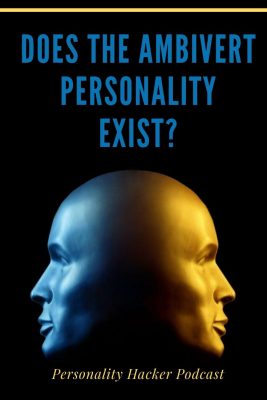Download Episode Here – right click link and select “Save Link As…”
In this episode Joel and Antonia talk about the ambivert personality and whether or not it exists.
In this podcast on the ambivert personality you’ll find:
- What is an Ambivert Personality? Does it really exist?
- All of us have one introverted and one extraverted process in dealing with the mental world
- Example: ENFP. Extraverted Intuition/Introverted Feeling
- Both introverted and extraverted processes are important and as you grow and develop these processes, the more you appear as a person with an ambiverts personality.
- We generally assume that extraversion means social (extraversion with people) and we assume that introversion excludes other human beings. However there are mental processes that are extraverted but are not social, and there are introverted processes that necessitates getting in touch with people.
- Ambiverts are the ones that who have a strong association of these two processes. They can see the part of them that is both extraverted and introverted.
- Don’t mistake your identity to a four-letter code, that’s a starting place of understanding how your mind works. You are way more than what any personality system can type you. Don’t assume that it explains everything about you.
- Your co-pilot is the highest leverage growth opportunity for you. The point of the map is to simplify.
- You need different styles of maps for understanding personality development and how your mind works.
To subscribe to the podcast, please use the links below:
Subscribe with iTunes
Non iTunes Link
Download The Android App
Subscribe on Soundcloud
Subscribe with Stitcher
If you like the podcast and want to help us out in return, please leave an honest rating and review on iTunes by clicking here. It will help the show and its ranking in iTunes immensely! We would be eternally grateful!
Want to learn more?
Discover Your Personal Genius
We want to hear from you. Leave your comments below…



Share:
Podcast - Episode 0043 - Permission To Be Awesome
Podcast - Episode 0045 - Developing A Generosity of Spirit
19 comments
Antonia,
Are you following a Jungian theory of individuation where the goal is to integrate your functions into a balanced mandala configuration? I think that is the Pygmalion project that Kiersey cautions us. The goal of individuation shouldn’t be to try to bump up your lower functions but rather to identify the proper configuration of the function stack. We are all condemned to being ourselves. We need to know our natural type and learn how to manage what we have. Our progress doesn’t come from changing individual functions but learning the point where we need to ally ourselves with someone whose personality is better suited to accomplishing the stage of a project that we aren’t equipped to handle proficiently. At some point, all individuals are failures. Success emerges when we integrate/cooperate with others collectively.
Some people are naturally balanced between thinking and feeling or sensation and intuition. Most people are maladapted by virtue of their experience, or lack of experience with parents and other authorities. What shows up on a paper and pencil test is the person’s opinion of their adapted personality. After all, the person who says he is a certain type makes that claim from a very biased position. Usually this isn’t catastrophic because humans are quite plastic. But, some are extremely maladapted. It is possible under trauma to adopt a personality diametrically opposite to what you would develop under normal conditions.
This brings up an important question. If you suddenly feel you have made a break through after trying to develop your auxiliary function, do you really know that you have developed that function or whether that function was naturally your dominant and you previously were suppressing your dominant with your auxiliary because of a maladaptation? You can’t really be sure.
What law outside of Jung’s map says you can’t be so closely balanced between two aspects of your functions so that the best description would be that you are indeed both? The rule that if your dominant is extroverted then your auxiliary function must be introverted – Who decided that? Where is the data? Without data we are left with ambiguity and ambiguity craves dogma to settle things.
Arbitrary rules are just one more roadblock to self-discovery. “You must not violate the rules.” If a person doesn’t feel solidly introverted or extroverted don’t force them to comply with the theory. Let them be both because who gives the coach or therapist the authority of Pygmalion?
That is probably true. Our primary focus is on the importance of developing that secondary (or, “Co-Pilot”) process, and so assumes the individual isn’t perfectly balanced. So, in a convoluted way, our core audience isn’t ambiverted by nature of who it is we’re talking to.
Does that make sense? :p
A
Antonia,
I see your point. I am not trying to be a “griefer”. I think the work you are doing is excellent. You and Joel are born communicators and you have chosen to communicate some of the best information available on personality.
I just feel that if a person is balanced between two functions we shouldn’t be dogmatic. Some people need a place holder such as ambiversion because it actually reflects their development. I think there is more benefit than harm in allowing people to be their ambiverted selves.
These two functions won’t ‘switch’ seats. You will have a definitive preference for your natural Driver process. It remains your flow state and your ‘favorite tool in your toolbox’. The more you develop your Co-Pilot, though, the less hyper-reliant you are on the Driver. You become more balanced and familiar with both the introverted and extraverted worlds.
An INFP won’t become an ENFP and vice-versa. But an INFP will become more comfortable with the outer world using their Exploration process (so they may appear more chatty, or comfortable in groups, etc), and an ENFP is going to be more comfortable navigating their ‘inner world’ terrain using Authenticity (and may appear more calm, centered with less compulsion to be performing for others).
A
John – I think the reason I keep mentioning Korzybski’s “map” quote is because it’s the basis of how I see all models. If a model is helpful and working for you, use it until it stops working.
Most people are not used to models. They aren’t systems thinkers. The easier the barrier of entry for a model, the more accessible it is to a higher percentage of people. MB has a low barrier of entry. Introducing people to the next more complicated construct of it – cognitive functions – usually crashes and burns because understanding the concept is too challenging. Not that people aren’t smart, they simply aren’t used to thinking in models. My observation (which is in no way reality) is that guiding others into an understanding of cognitive functions is an amazing first step in introducing models and systems thinking at all. It’s fun. It’s self-reflective. It’s a great introduction to personal development which already has a built-in infrastructure. And it’s not dangerous to see life through this lens. Since you correctly guessed my history in an email conversation between us, you know that I’m fully aware of dangerous models that people buy hook, line and sinker. This is not one of those paradigms or self-understanding tools that end up trapping others into deferred life programs and/or encouraging one to outsource their values.
It’s not complete. More maps are needed to have a fuller, richer understanding of the self and ‘reality’ (whatever that is). In fact, at a certain point the model fully breaks down and becomes meaningless. But that’s the next step, and from where I stand one can’t skip steps.
I’m thinking you want the most detailed map possible. But you know the more fully a map represents ‘reality’ the more complex it is, and eventually it becomes useless. The key is to find a map that accurately depicts ‘reality’ (as is perceived by an almost endless series of feedback mechanisms), isn’t too off-kilter as to make one disingenuous or create cognitive dissonance, and isn’t so complex as to become useless. The map one settles on should be based on one’s current level of sophistication with map-reading, and it will invariably change over time in favor of better or simply newer maps. Though the best maps are generally revisited as some point in your life.
So, all of that said, if you don’t like the MB map, that’s okay. If you disagree with the way we describe the ambivert terrain, okay. There are other ways of seeing it. Again, it’s not dangerous to see it either way. No one is going to take up arms based on an interpretation of how personal energy management works. And if how a person sees introversion/extraversion/ambiversion is harming their energy management and making them sick (psychologically or physically) then it’s on the person themselves to determine this and release the tool that isn’t serving them.
To me, Jungian cognitive functions are a solid map for our audience. In Jungian functions, it works the way we described in this podcast. And when people outgrow it or exchange it in favor for other maps (models), or simply add more maps to their collection I in no way take that personally. I sold a map at a certain part of the road to help at a certain part of the journey. I don’t think everyone has to stop at my little shack on the road.
A